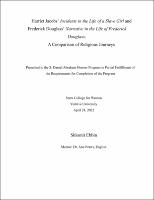Please use this identifier to cite or link to this item:
https://hdl.handle.net/20.500.12202/8231| Title: | Harriet Jacobs’ Incidents in the Life of a Slave Girl and Frederick Douglass’ Narrative in the Life of Frederick Douglass: A Comparison of Religious Journeys |
| Authors: | Peters, Ann Ebbin, Shlomit |
| Keywords: | Frederick Douglass Harriet Jacobs fugitive slaves slave narratives religious attitudes |
| Issue Date: | 28-Apr-2022 |
| Publisher: | Yeshiva University |
| Citation: | Ebbin, S. (2022, April 28). Harriet Jacobs’ Incidents in the Life of a Slave Girl and Frederick Douglass’ Narrative in the Life of Frederick Douglass: A Comparison of Religious Journeys. [Undergraduate honors thesis, Yeshiva University]. |
| Series/Report no.: | S. Daniel Abraham Honors Student Theses;April 28, 2022 |
| Abstract: | Harriet Jacobs and Frederick Douglass were two fugitive slaves who write narratives during the abolitionist movement. Narrative of the Life of Frederick Douglass was published in 1845 and Jacobs’ Incidents in the Life of a Slave Girl was published in 1861. These stories are both written with purpose, and both of them use religion as part of their strategy. At first glance, these two former slaves seem to have a similar view of religion, mainly, they both expose and condemn the hypocrisy of Christian slave owners. And yet, they diverge in their personal attitudes toward religion and God. Douglass claims to only condemn slave-holding Christianity, yet the progression of his faith throughout his narrative doesn’t commend Christianity either. Following Douglass through his life as a child with blind faith to his freedom while studying closely his retrospective voice reveals that his story is rather one of finding atheism. Jacobs, on the other hand, maintains a strong relationship with God throughout — or does she? In between her praises of God and unwavering belief, lies some anger at God for the situation she’s in, and she’s unable to keep that fully hidden from her readers. However, Jacobs is different than Douglass because, despite the way she questions God’s doings, she never gets to the point of disbelief. Although their religious outcomes are different, they are once again parallel in their mission: to gain followers for the abolitionist movement through the use of religion, presenting their deviances from it as a result of slavery. (from Introduction) |
| Description: | Undergraduate honors thesis / Open Access |
| URI: | https://hdl.handle.net/20.500.12202/8231 |
| Appears in Collections: | S. Daniel Abraham Honors Student Theses |
Files in This Item:
| File | Description | Size | Format | |
|---|---|---|---|---|
| Shlomit Ebbin Harriet Jacobs Frederick Douglass OA Apr2022.pdf | 144.37 kB | Adobe PDF |  View/Open |
This item is licensed under a Creative Commons License

